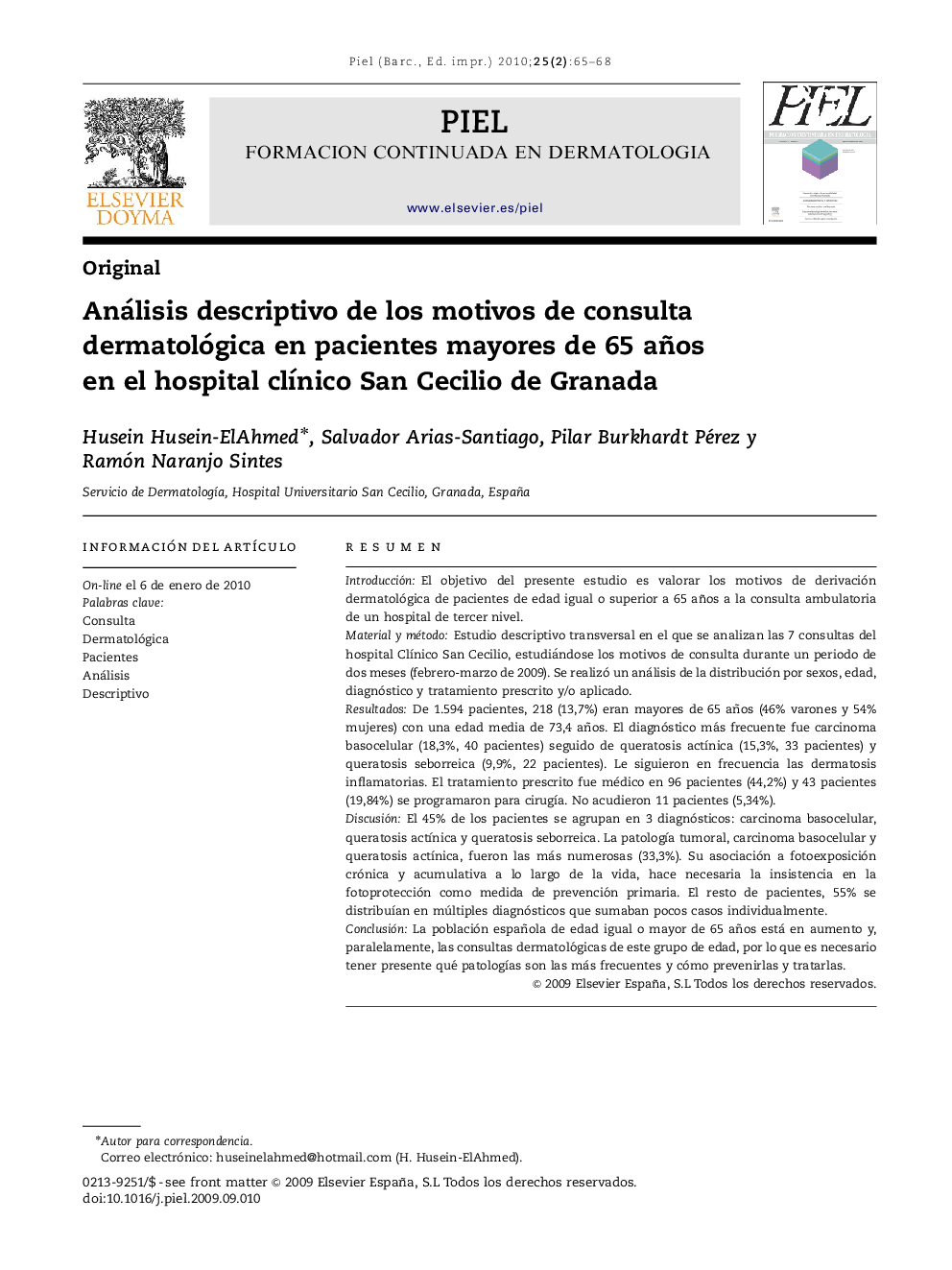| Article ID | Journal | Published Year | Pages | File Type |
|---|---|---|---|---|
| 3221665 | Piel | 2010 | 4 Pages |
ResumenIntroducciónEl objetivo del presente estudio es valorar los motivos de derivación dermatológica de pacientes de edad igual o superior a 65 años a la consulta ambulatoria de un hospital de tercer nivel.Material y métodoEstudio descriptivo transversal en el que se analizan las 7 consultas del hospital Clínico San Cecilio, estudiándose los motivos de consulta durante un periodo de dos meses (febrero-marzo de 2009). Se realizó un análisis de la distribución por sexos, edad, diagnóstico y tratamiento prescrito y/o aplicado.ResultadosDe 1.594 pacientes, 218 (13,7%) eran mayores de 65 años (46% varones y 54% mujeres) con una edad media de 73,4 años. El diagnóstico más frecuente fue carcinoma basocelular (18,3%, 40 pacientes) seguido de queratosis actínica (15,3%, 33 pacientes) y queratosis seborreica (9,9%, 22 pacientes). Le siguieron en frecuencia las dermatosis inflamatorias. El tratamiento prescrito fue médico en 96 pacientes (44,2%) y 43 pacientes (19,84%) se programaron para cirugía. No acudieron 11 pacientes (5,34%).DiscusiónEl 45% de los pacientes se agrupan en 3 diagnósticos: carcinoma basocelular, queratosis actínica y queratosis seborreica. La patología tumoral, carcinoma basocelular y queratosis actínica, fueron las más numerosas (33,3%). Su asociación a fotoexposición crónica y acumulativa a lo largo de la vida, hace necesaria la insistencia en la fotoprotección como medida de prevención primaria. El resto de pacientes, 55% se distribuían en múltiples diagnósticos que sumaban pocos casos individualmente.ConclusiónLa población española de edad igual o mayor de 65 años está en aumento y, paralelamente, las consultas dermatológicas de este grupo de edad, por lo que es necesario tener presente qué patologías son las más frecuentes y cómo prevenirlas y tratarlas.
IntroductionThe aim of this study was to assess the reasons for referring patients aged 65 years or more to the dermatology outpatient department of our third level hospital.Material and MethodsWe performed a descriptive cross-sectional study of the reasons for referrals over a 2-month period (February-March 2009). An analysis of distribution by age, sex, diagnosis and the treatment prescribed and/or applied was performed.ResultsOf 1,594 patients, 218 (13.7%) were older than 65 years (46% males and 54% women) with a mean age of 73.4 years. The most frequent diagnosis was basal cell carcinoma (18.3%, 40 patients), followed by actinic (15.3%, 33 patients) seborrheic keratosis (9.9%, 22 patients), and inflammatory dermatoses. Medical treatment was prescribed in 96 patients (44.2%) and 43 (19.84%) were scheduled for surgery. Eleven patients failed to attend (5.34%).DiscussionA total of 45% of the patients were grouped into three diagnoses: basal cell carcinoma, actinic keratosis and seborrheic keratosis. Oncological diseases, basal cell carcinoma and actinic keratosis were the most frequent diagnoses (33.3%). The association of these entities with chronic and cumulative photoexposure over the lifespan highlights the need to stress photoprotection as a primary prevention measure. The remaining 55% of the patients were distributed in multiple diagnoses that individually accounted for few cases.ConclusionBoth the Spanish population aged over 65 and dermatological consultations in this age group are increasing. Consequently, the most common diseases and their prevention and treatment in this population should be kept in mind.
